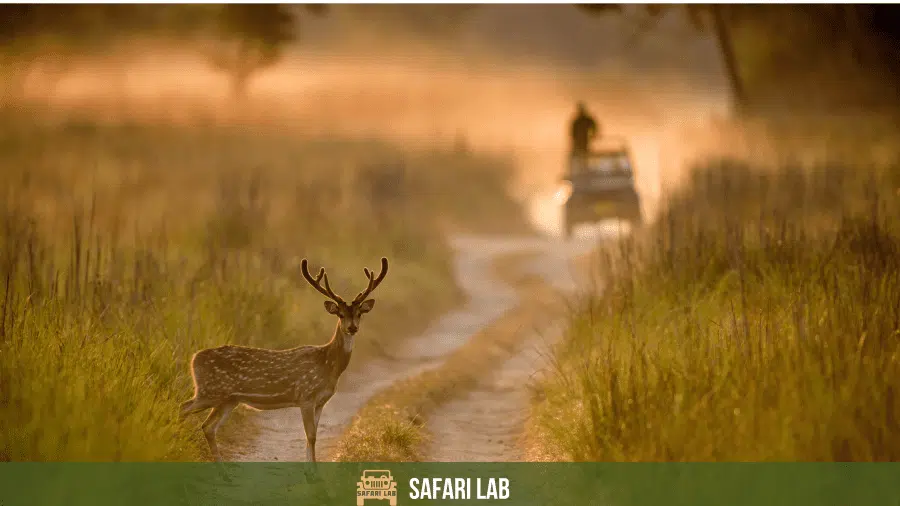There’s nothing more fascinating than to see a big cat in all its glory dart behind its prey and bring it down in the blink of an eye.
Tigers are among the most powerful terrestrial predators in the world. Their muscles are specialized for strength and agility, making them the epitome of predatory prowess. The secret behind their power lies in the density and composition of their muscle fibers, which are adapted for explosive power.
Studying tiger anatomy helps us appreciate these magnificent creatures and informs conservation efforts. It also offers insights into evolutionary biology and can inspire technological advances modeled after biological systems.
Understanding the Anatomy of the Tiger – An Apex Predator designed for the kill
Tigers are majestic creatures that command awe and respect.
As apex predators, they are known for their strength, agility, and hunting prowess. One of the key factors that contribute to their success as hunters is their powerful muscles.
In this comprehensive guide, we will delve into the anatomy of the tiger’s muscles, muscle mass data, unveiling the secrets behind their immense power.
Tiger Length, Height & Weight
Tigers are magnificent creatures, known for their strength, power, and beauty. As the largest of the big cats, they have an impressive physical stature that sets them apart from other animals in the animal kingdom. In this comprehensive guide, we will delve into the secrets of tiger’s muscles and explore their incredible length, height, and weight.
The Tiger’s Length
When it comes to length, tigers are truly remarkable. Males, also known as toms, can reach up to 3.3 meters (11 feet) in length from head to tail. This measurement includes their long, muscular body and their graceful tail, which alone can measure around 90-110 centimeters (35-43 inches). The tail serves multiple purposes for tigers, aiding in balance during hunting and acting as a communication tool to signal other tigers.
Female tigers, or queens, are slightly smaller in size but still possess an impressive length. On average, they measure around 2.6 meters (8.5 feet) from head to tail. Despite being smaller, female tigers are equally powerful and play a vital role in the survival of their species.
The Average Tiger’s Height
In addition to their length, tigers also have a considerable height. At the shoulder, male tigers typically stand around 1 meter (3.3 feet) tall. This height gives them an advantage when it comes to hunting, allowing them to spot prey from a distance and pounce with precision. Female tigers have a similar shoulder height, although they may be slightly smaller due to their overall size difference.
Tiger’s Weight
When it comes to weight, tigers are true heavyweights of the animal kingdom. Male tigers can weigh up to an astonishing 300 kilograms (660 pounds).
This weight is mainly due to their muscular build, which is essential for hunting and defending their territory. Female tigers, on the other hand, are slightly lighter, weighing around 180 kilograms (400 pounds).
Despite their smaller size, female tigers are just as agile and formidable as their male counterparts.
The impressive length, height, and weight of tigers are a testament to their incredible power and adaptability. These physical attributes enable them to survive in a variety of habitats, from dense forests to open grasslands. Their large size also serves as a deterrent to potential predators, making them one of the most dominant predators in their ecosystems.
The Tiger’s Muscle Tone
Tigers are awe-inspiring creatures, known for their immense power and strength. Their muscles play a crucial role in enabling these majestic animals to thrive in their natural habitats. In this comprehensive guide, we will delve into the secrets behind a tiger’s muscle tone, shedding light on their extraordinary power.
Composition of Tiger Muscles
The muscles of tigers are composed of a combination of fast-twitch and slow-twitch muscle fibers. Fast-twitch fibers are responsible for generating quick bursts of power and speed, while slow-twitch fibers provide endurance for sustained activity. This unique blend of muscle fibers allows tigers to exhibit explosive strength as well as the ability to engage in prolonged physical exertion.
When it comes to hunting, tigers rely on their explosive power to capture prey. Their fast-twitch muscle fibers are instrumental in achieving this. These fibers contract rapidly, generating tremendous force in a short period.
This enables tigers to swiftly pounce on their unsuspecting victims or launch themselves through the dense undergrowth with agility and precision.
Leg Muscles
The Foundation of a Hunter’s Speed and Agility Tigers are renowned for their incredible speed and agility. Their leg muscles play a crucial role in enabling them to run, jump, and pounce on their prey with lightning-fast precision.
These muscles, particularly the quadriceps and hamstrings, are incredibly strong and well-developed. They provide the necessary force for tigers to launch themselves into high-speed chases, covering great distances in pursuit of their quarry.
Back and Shoulder Muscles
The Grip of Death Once a tiger catches its prey, it needs to secure a firm grip to ensure a successful kill. The back and shoulder muscles of the tiger are exceptionally powerful and allow them to grip and hold onto their prey tightly.
These muscles, including the latissimus dorsi and trapezius, provide the necessary strength and stability for a tiger to maintain control over its struggling victim.
Neck and Jaw Muscles
Precision and Power in Every Bite Tigers have large and robust neck and jaw muscles that enable them to deliver deadly bites to their prey.
The muscles in their neck, such as the sternomastoid and splenius capitis, provide the necessary support and flexibility required for precise movements during a hunt.
Meanwhile, the strong jaw muscles, including the masseter and temporalis, generate an incredible amount of force, allowing tigers to deliver bone-crushing bites that can immobilize their prey instantly.
Paws and Claws
Tools of a Ruthless Hunter The paws of a tiger are not just elegant and beautiful, but also incredibly powerful. They are equipped with large muscles that provide the necessary strength for a tiger to catch and kill its prey.
The muscles in the tiger’s forelimbs, such as the flexor digitorum profundus, enable them to extend their claws with ease, giving them an added advantage when it comes to catching and holding onto their prey.
Additionally, the sharp claws of a tiger serve multiple purposes. They can be used to deliver swift and deadly strikes, slashing through thick hides and inflicting fatal wounds. Tigers also use their claws for climbing trees, marking territory, and defending themselves against threats.
The Strength of the Tiger Jaw – Weapons of destruction
Tiger jaws are robust, with a structure that allows them to deliver powerful bites. Their jaws have a large coronoid process that gives leverage to the jaw muscles, allowing them to exert a great amount of force when biting down.
Each set of teeth plays a pivotal role in allowing the tiger to capture and devour its prey. Tigers have a total of 30 teeth, including sharp canines, incisors, premolars, and molars.
The canines, also known as fangs, are the most prominent and impressive teeth in a tiger’s mouth. They are long, curved, and extremely sharp, measuring up to 3 inches in length. These canines are specifically designed for puncturing and gripping the prey, allowing the tiger to deliver a deadly bite to the victim’s neck or throat.
The incisors are located at the front of the tiger’s mouth. They are smaller and less specialized compared to the canines, but still play a crucial role in grasping and tearing meat. The incisors are used for stripping flesh from the bones and other tasks that require precision.
Behind the canines and incisors, tigers have premolars and molars. These teeth are broader and flatter, with ridges specifically adapted for crushing and grinding. They aid in breaking down the prey’s bones and tough tissues, making it easier for the tiger to consume its meal.
The combination of powerful jaws and sharp teeth allows tigers to subdue and kill large prey animals. They can deliver a bite force of around 1,000 pounds per square inch (psi), which is strong enough to crush bones and disable their victims instantly. To give you some context into the power that this bite force can generate, the average human’s bite force is 160 PSI.
Imagine the sheer power that these magnificent animals can generate. It can pop someone’s skull like a balloon.
The Power of Tiger’s Limbs
Tigers are majestic creatures that command respect and admiration. One of the reasons for their awe-inspiring presence is their powerful muscles.
The limbs of a tiger are a testament to their strength and agility, allowing them to navigate their environment with incredible speed and precision.
In this comprehensive guide, we will delve into the secrets of a tiger’s muscular limbs and explore the immense power they possess.
The Legs: A Foundation of Strength
The legs of a tiger are a force to be reckoned with. Their muscular structure is designed to provide maximum power and stability. The quadriceps, located in the front of the thigh, are responsible for extending the leg and propelling the tiger forward. These muscles are exceptionally strong, allowing the tiger to sprint at incredible speeds and make swift turns while in pursuit of prey.
The hamstrings, located at the back of the thigh, are equally important. They work in conjunction with the quadriceps to provide balance and control during movements. These muscles enable the tiger to maintain stability while navigating uneven terrain and executing precise jumps and leaps.
The Shoulders and Arms: Powerhouses of Strength
While the legs play a crucial role in a tiger’s movement, the shoulders and arms are equally impressive. The shoulder muscles, such as the deltoids and trapezius, provide the foundation for strength and stability in the upper body. These muscles allow the tiger to carry heavy loads, such as large prey, ensuring their survival in the wild.
The biceps and triceps, located in the upper arm, are responsible for the tiger’s ability to grasp and hold onto prey. These muscles provide the necessary strength to secure their food source, giving them sustenance and energy.
Agility and Balance: The Key to Success
In addition to raw power, a tiger’s muscles also contribute to their agility and balance. The abdominal muscles, including the obliques and rectus abdominis, provide stability and support to the tiger’s body during rapid movements. These muscles allow the tiger to make sharp turns, pivot quickly, and maintain balance while navigating obstacles.
The back muscles, such as the latissimus dorsi and erector spinae, also play a crucial role in a tiger’s agility. These muscles provide the necessary strength and flexibility for the tiger to arch their back and execute precise movements, further enhancing their hunting prowess. ***
Stalking – Designed for Stealth, Not Speed
When we think of tigers, we often associate them with speed. However, contrary to popular belief, tigers are not built for sustained speed like cheetahs. Instead, their muscles are perfectly designed for stalking their prey.
Stalking requires a combination of strength, agility, and stealth, all of which are enhanced by the unique musculature of tigers.
Tigers have a higher percentage of fast-twitch muscle fibers compared to slow-twitch fibers. Fast-twitch muscle fibers are responsible for generating quick bursts of power and speed.
They enable tigers to pounce on their prey with lightning-fast reflexes, propelling them forward in an explosive manner. These fibers provide the necessary strength and agility required for stalking.
However, it’s important to note that tigers also possess a certain level of endurance, although not as much as animals adapted for long-distance running. This is due to the presence of a moderate amount of slow-twitch muscle fibers. These fibers allow tigers to maintain a steady pace during a chase if necessary.
Leverage and Flexibility – The Key to Precision
Another aspect of tiger’s musculature that contributes to their power is their leverage and flexibility. Tigers have long, powerful limbs and a flexible spine, allowing them to make precise and controlled movements. This enables them to stalk their prey silently, inching closer without alerting their target.
The shoulder and hip joints of tigers are highly mobile, providing them with a wide range of motion. This flexibility allows them to navigate through dense forests, jump from great heights, and climb trees effortlessly. Tigers are known for their ability to leap onto their prey from a concealed position, relying on their powerful muscles and flexible bodies to execute these remarkable acrobatic feats.
Muscle Adaptations – The Secret Sauce
Tigers have undergone various muscle adaptations over time to enhance their hunting abilities. Their forelimbs are particularly strong, allowing them to overpower and bring down large prey. The muscles in their forelimbs are well-developed, providing them with the strength to hold onto struggling prey and deliver a swift and lethal bite to the neck.
Additionally, tigers possess a specialized set of muscles known as the nuchal ligament. This thick band of connective tissue runs along the back of their neck
The Tiger’s Claws – The Icing on an already-formidable cake
One of the key features that contributes to a tiger’s power is its claws. These sharp and curved weapons play a vital role in the tiger’s hunting and survival strategies.
The curved shape of a tiger’s claws is designed perfectly for gripping and holding onto prey. Just like how our fingers naturally curl when we grab something, the same concept applies to tigers. Their claws are not only long and sharp but also have a slight curve, allowing them to dig into the flesh of their prey and maintain a secure grip.
Breaking down the Tiger’s claw
The claws are divided into three main parts: the outer sheath, the middle layer, and the inner core.
The outer sheath is the hard, protective covering of the claw. It is made of a tough substance called keratin, which is the same material that makes up our fingernails. This outer layer helps to keep the claw strong and prevents it from breaking easily during hunting or other activities.
Beneath the outer sheath is the middle layer, which is softer and more flexible. This layer gives the claw some elasticity and allows it to bend slightly when gripping onto prey. The combination of the hard outer sheath and the flexible middle layer gives the claw its curved shape, enhancing its holding ability.
At the center of the claw is the inner core, where blood vessels and nerves are located. This core provides nourishment to the claw and also allows the tiger to feel sensations through its claws, such as texture and pressure.
The curved shape of the tiger’s claws is an evolutionarily advantageous adaptation for hunting. It allows them to maintain a firm grip on their prey, preventing it from escaping. Tigers often use their claws to immobilize their prey by digging them into the flesh, using their powerful muscles to hold onto their catch.
In addition to hunting, the curved claws also serve other purposes for tigers. They are used for climbing trees, marking territory, defending themselves, and maintaining balance while running or leaping.
Overall, the curved shape of a tiger’s claws is a remarkable feature that has evolved to suit their predatory lifestyle. It enhances their ability to capture and hold onto prey, making them highly efficient and successful hunters.
The Science Behind Tiger Muscles
Tigers have evolved to optimize their muscle power for the demands of their environment, including hunting and survival strategies.Over millions of years, predators have evolved to optimize their muscle power in order to enhance their hunting and survival strategies. These adaptations can be observed in various aspects of their anatomy and physiology.
1. Muscular System: Predators possess strong and well-developed muscles that enable them to generate force quickly and efficiently. Their muscles are typically composed of fast-twitch fibers that contract rapidly, providing bursts of power required for chasing and capturing prey.
2. Skeletal Structure: Predatory animals often have a streamlined skeletal structure, reducing unnecessary weight and allowing for rapid movements. Limbs are designed for speed, agility, and precision. For instance, big cats like cheetahs have long and slender bodies with flexible spines, which enable them to achieve incredible bursts of speed while maintaining balance.
3. Jaw Strength: Many predators rely on their jaw strength to kill or immobilize their prey. As a result, their jaws are often equipped with powerful muscles and specialized teeth. For example, carnivorous mammals like lions and wolves have strong jaw muscles and sharp, cutting teeth adapted for tearing flesh.
4. Senses: Predators have highly developed sensory systems, enabling them to locate and track their prey. They possess acute vision, hearing, and smell, which aid in detecting prey from a distance. This allows them to conserve energy and plan their hunting strategies effectively.
5. Energy Efficiency: Predators have evolved to optimize their energy expenditure during hunting. They exhibit a range of strategies such as stalking, ambush, and cooperative hunting to maximize their chances of success while minimizing energy loss. This is crucial for their survival, as failed hunts can lead to exhaustion and potential starvation.
6. Adaptations for Stealth: Many predators have adapted physical characteristics that aid in stealthy approaches towards their prey. These adaptations can include silent footsteps, camouflage, and the ability to blend into their environment. These features increase their chances of getting close enough to successfully capture their prey.
Overall, the optimization of muscle power in predators is a result of natural selection favoring traits that enhance hunting and survival strategies. These adaptations allow them to effectively capture and consume prey while minimizing energy expenditure and increasing their chances of survival in their respective environments.
FAQ
Q. What are the special features of a tiger’s anatomy?
A Tiger’s anatomy has several special features that make it well-suited for its lifestyle as a powerful predator. Some of these special features include Striped fur which help them blend into their surroundings and provide camouflage, Large paws and retractable claws, enhanced senses including night vision, which allows them to hunt effectively in low-light conditions & an adapted teeth and tongue which aid in grooming and stripping meat off bones. Their rough tongue acts like sandpaper and helps remove fur and feathers from their prey.
Q. What is the average size of a tiger?
A. The average size of different tiger species varies. The Siberian tiger, the largest subspecies, can measure up to 3.3 meters (11 feet) in length and weigh up to 300 kilograms (660 pounds). The Bengal tiger is slightly smaller, with males averaging about 2.7 to 3.1 meters (8.9 to 10.2 feet) in length and weighing between 180 to 258 kilograms (397 to 569 pounds). The Indochinese tiger, the Malayan tiger, and the South China tiger have similar sizes, generally ranging from 2.4 to 2.7 meters (7.9 to 8.9 feet) in length and weighing 150 to 195 kilograms (330 to 430 pounds). The Sumatran tiger, the smallest living subspecies, averages about 2.2 to 2.55 meters (7.2 to 8.4 feet) in length and weighs around 100 to 140 kilograms (220 to 310 pounds).
Q. How does the strength of a tiger compare to other animals?
A. Tigers are among the strongest of the apex predator mammals, both in terms of physical strength and bite force. Compared to other large predators like lions and bears, tigers have a more muscular build and are capable of carrying prey up to twice their own body weight. While lions have the advantage of social hunting tactics, a single tiger can overpower larger prey due to its individual strength. Bears, particularly polar and grizzly bears, also exhibit immense strength and can rival tigers in terms of raw power, but they are generally less predatory by nature. In terms of bite force, tigers possess one of the strongest bites among big cats, stronger than that of lions and leopards, but slightly less than that of jaguars. Overall, the tiger’s combination of muscular strength, agility, and powerful jaws makes it one of the most formidable apex predators in the mammalian kingdom.
Q. Are there any unique anatomical characteristics specific to tigers?
Tigers, the largest of all the big cat species, are endowed with a range of unique anatomical traits that confer upon them a formidable presence in the wild. Their muscular bodies are supported by strong, dense bones in their front legs, which are essential for overpowering large prey. The hind legs, being longer than the front, provide tigers with an exceptional ability to leap forward distances up to 10 meters, aiding them in the capture of their targets. Tigers boast the largest canines among big cats, measuring between 6.4 to 7.6 centimeters, which, along with their powerful jaws attached to a sagittal crest, allow them to deliver a crushing bite. Their retractable claws, which can extend up to 10 centimeters, are another evolutionary marvel, enabling them to grasp and hold onto prey effectively while remaining sharp for future hunts. Furthermore, the tiger’s striped coat serves as effective camouflage, blending seamlessly into the forest and grassland habitats, making them nearly invisible to unsuspecting prey. These physical characteristics, combined with acute senses such as excellent night vision and hearing, make the tiger a supreme predator, perfectly adapted to its role at the apex of the food chain.
Q. Are the Siberian Tiger’s muscles different from those of a Bengal Tiger?
A. The Siberian tiger and the Royal Bengal tiger, while both being subspecies of Panthera tigris, have evolved to thrive in different environments, which has influenced certain physical characteristics, including musculature. The Siberian tiger, adapted to the cold climates of Eastern Russia and parts of China, tends to have a larger body mass and a thicker coat for insulation against the cold. This may result in slightly bulkier musculature, which is necessary not only for generating sufficient body heat but also for traversing through snow and bringing down large, heavy prey like wild boar and deer.
The Royal Bengal tiger, on the other hand, inhabits the warmer and more tropical environments of India, Bangladesh, Nepal, and Bhutan. It is generally leaner, though still powerful and muscular, which is an adaptation to the dense forest and grassland habitats where agility and stealth are crucial for hunting. The muscle composition between the two subspecies is similar, with both having a high proportion of fast-twitch muscle fibers for explosive strength and speed. However, the overall muscle mass and bulk might be greater in the Siberian tiger due to its larger size and the demands of its habitat.
Conclusion
The muscular system of a tiger is a marvel of nature, finely tuned for the life of an apex predator. It commands respect and admiration for its efficiency and raw power.
Understanding the tiger’s anatomy deepens our appreciation for these creatures and highlights the importance of preserving their habitats and populations.
Citations :
1. https://ielc.libguides.com/sdzg/factsheets/tiger/characteristics 2. https://nationalzoo.si.edu/animals/tiger 3. https://study.com/academy/lesson/tiger-adaptations-lesson-for-kids.html 4. https://seaworld.org/animals/all-about/tiger/characteristics/ 5. https://www.tigers-world.com/tiger-anatomy/ 6. https://www.wwfindia.org/about_wwf/priority_species/bengal_tiger/why_save_the_tigers/

























